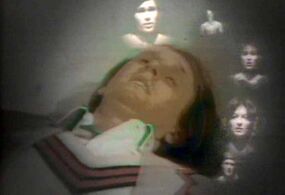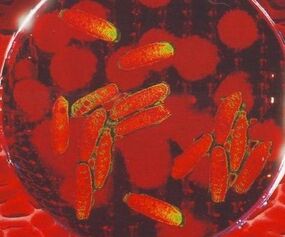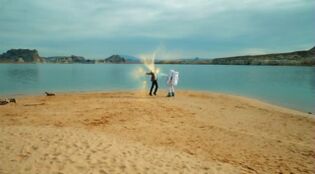The Doctor's death: Difference between revisions
Tag: 2017 source edit |
Tag: 2017 source edit |
||
| Line 14: | Line 14: | ||
Following [[War Doctor|their forgotten ninth incarnation]] and an incident which saw the [[Tenth Doctor]] regenerate but keep the same [[face]], the [[incarnation]] who identified as the [[Eleventh Doctor]] emerged as the product of the Doctor's twelfth regeneration, the last of their original [[life cycle]], and so believed himself to be "the last Doctor" until the Time Lords enabled him to regenerate again. ([[TV]]: ''[[The Time of the Doctor (TV story)|The Time of the Doctor]]'', [[AUDIO]]: ''[[Regeneration Impossible (audio story)|Regeneration Impossible]]'') The [[Twelfth Doctor]], ([[TV]]: ''[[Kill the Moon (TV story)|Kill the Moon]]'') [[the Master]] ([[TV]]: ''[[The Doctor Falls (TV story)|The Doctor Falls]]'') and even [[Rassilon]] himself were uncertain as to how many regenerations the Doctor now possessed. ([[TV]]: ''[[Hell Bent (TV story)|Hell Bent]]'') | Following [[War Doctor|their forgotten ninth incarnation]] and an incident which saw the [[Tenth Doctor]] regenerate but keep the same [[face]], the [[incarnation]] who identified as the [[Eleventh Doctor]] emerged as the product of the Doctor's twelfth regeneration, the last of their original [[life cycle]], and so believed himself to be "the last Doctor" until the Time Lords enabled him to regenerate again. ([[TV]]: ''[[The Time of the Doctor (TV story)|The Time of the Doctor]]'', [[AUDIO]]: ''[[Regeneration Impossible (audio story)|Regeneration Impossible]]'') The [[Twelfth Doctor]], ([[TV]]: ''[[Kill the Moon (TV story)|Kill the Moon]]'') [[the Master]] ([[TV]]: ''[[The Doctor Falls (TV story)|The Doctor Falls]]'') and even [[Rassilon]] himself were uncertain as to how many regenerations the Doctor now possessed. ([[TV]]: ''[[Hell Bent (TV story)|Hell Bent]]'') | ||
When the [[Thirteenth Doctor]] visited [[Daughter of Mine]] to free her from the [[mirror]] in which she was imprisoned, Daughter of Mine mentioned a [[The Doctor (Battlefield)|redheaded Doctor]] who "thought he was the last", which the present Doctor did not recognise. ([[WC]]: ''[[The Shadow in the Mirror (webcast)|The Shadow in the Mirror]]'') | When the [[Thirteenth Doctor]] visited [[Daughter of Mine]] to free her from the [[mirror]] in which she was imprisoned, Daughter of Mine mentioned a [[The Doctor (Battlefield)|redheaded Doctor]] who "thought he was the last", which the present Doctor did not recognise. ([[WC]]: ''[[The Shadow in the Mirror (webcast)|The Shadow in the Mirror]]'') [[Time (Set Piece)|Time]] told the Doctor that she would not outrun her. Claiming that the Doctor's time was heading to its end, Time warned: | ||
{{Quote|Nothing is forever. No regeneration, no life.|Time.|The Vanquishers (TV story)}} | |||
== Impact on the universe == | == Impact on the universe == | ||
Revision as of 18:26, 30 January 2022
Much like their origin, the Doctor's death was a matter of conflicting accounts and alternate timelines. (PROSE: Alien Bodies, TV: The Impossible Astronaut, The Name of the Doctor)
The Doctor's mortality
Through their ability to regenerate, the Doctor was able to "cheat death" on numerous occasions. (TV: The Tenth Planet, The Parting of the Ways) However, the Tenth Doctor noted that he could be killed without allowing for regeneration. (TV: The End of Time) As such, the Doctor was not truly immortal, which the Fifth Doctor deemed impossible even for a Time Lord. (TV: The Five Doctors) Even allowing for regeneration, the Tenth Doctor regarded the change it entailed as a form of death. (TV: The End of Time)
Visiting the Garden of Fond Memories on Necros, the Sixth Doctor was shocked to find a statue made in his likeness, which he took as evidence that he would die without regenerating. He noted to Peri Brown that, being a time traveller, it was possible for them both to travel to a point after they had died. Peri, however, believed that the statue was a "joke" and a "gag", that someone was "having [him] on". To their shock, the statue fell on top of the Doctor, apparently crushing him, only for the Doctor to push aside the statue, finding that it was not genuine stone rather "an elaborate theatrical effect." The Doctor later determined that Davros, who had masqueraded as the Great Healer of Necros, was responsible for the statue; he complimented Davros on its "very good likeness" but added that "[he] really shouldn't have bothered." (TV: Revelation of the Daleks)
I never thought precognisance of my own death would be so disturbing.
The Valeyard was introduced to the Sixth Doctor by the Tremas Master as "an amalgamation of the darker sides of [his] nature, somewhere between [his] twelfth and final incarnation." (TV: The Ultimate Foe) In a story related by the Valeyard, the thirteenth and final incarnation of the Doctor supposedly composed a set of scrolls which detailed his work to bypass the limit of twelve regenerations and that the Valeyard himself was created as a Time Tot on a mud planet orbiting Etarho as a result of the Doctor's experiments. The Valeyard's claim, however, was doubted by the Sixth Doctor. Indeed, the Doctor found what appeared to be his final incarnation on Etarho to have been the Valeyard masquerading as him. (AUDIO: Trial of the Valeyard)
Following their forgotten ninth incarnation and an incident which saw the Tenth Doctor regenerate but keep the same face, the incarnation who identified as the Eleventh Doctor emerged as the product of the Doctor's twelfth regeneration, the last of their original life cycle, and so believed himself to be "the last Doctor" until the Time Lords enabled him to regenerate again. (TV: The Time of the Doctor, AUDIO: Regeneration Impossible) The Twelfth Doctor, (TV: Kill the Moon) the Master (TV: The Doctor Falls) and even Rassilon himself were uncertain as to how many regenerations the Doctor now possessed. (TV: Hell Bent)
When the Thirteenth Doctor visited Daughter of Mine to free her from the mirror in which she was imprisoned, Daughter of Mine mentioned a redheaded Doctor who "thought he was the last", which the present Doctor did not recognise. (WC: The Shadow in the Mirror) Time told the Doctor that she would not outrun her. Claiming that the Doctor's time was heading to its end, Time warned:
Nothing is forever. No regeneration, no life.
Impact on the universe
Due to their impact on the universe, having "touched so many lives" and "saved so many people", the prospect of the Doctor's death would affect a great many people. Indeed, from an alternate reality in which River Song refused to kill the Doctor, news that the Doctor was dying led millions, all across time and space, to offer their help. (TV: The Wedding of River Song) At the same time, Vislor Turlough, companion to the Fifth Doctor, noted that the Doctor had many enemies who would delight in his death, an observation which Kamelion concurred with. (TV: The Caves of Androzani) However, even the Tremas Master once remarked that "a cosmos without the Doctor scarcely bears thinking about." (TV: The Five Doctors) Multiple occasions in which the Doctor was killed prematurely resulted in stars burning out across the universe. (AUDIO: The Furies, TV: Turn Left, The Name of the Doctor)
Two companions of the Twelfth Doctor, Bill Potts and Nardole, came to believe it was the Doctor's actions that ensured good always triumphed over evil in the universe, meaning that the Doctor's possible death would have dire effects for the cosmos. (TV: Twice Upon a Time) Indeed, the Fourth Doctor knew that humanity was able to defeat the Daleks on many occasions in part because of he and his other selves continued their interventions. (AUDIO: Energy of the Daleks) The Twelfth Doctor, after spending some time resisting regenerating even it if meant his final death, ultimately conceded to the TARDIS that the "silly old universe" still needed saving and that "[they'd] get it all wrong without me." (TV: Twice Upon a Time)
In a possible future stemming from the Eighth Doctor's life, (PROSE: The Tomorrow Windows) what appeared to be the final death of an alternate Twelfth Doctor led the Master and a shipful of Daleks, who were saved when the Doctor stopped their Zectronic Beam Controller from imploding, to openly renounce their evil ways. (TV: The Curse of Fatal Death)
Impact on the TARDIS
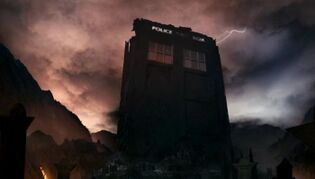
Anticipating his death in battle against the Daleks, the Ninth Doctor expected that the TARDIS would ultimately die without him, deeming that preferable to falling into Dalek hands. (TV: The Parting of the Ways) After the Tenth Doctor died in Donna's World, Rose Tyler believed that the TARDIS was dying. (TV: Turn Left) Experiencing a potential future in which he died on Trenzalore, the Eleventh Doctor observed the future TARDIS' size leak to be a sign that it was dying. The Doctor identified that the TARDIS was now his tomb, now containing his time stream. (TV: The Name of the Doctor)
Impact on companions
Denial and regret
Sarah Jane Smith tearfully urged the dying Third Doctor not to die. (TV: Planet of the Spiders) Similarily, Rose Tyler supported the Tenth Doctor after he was shot by a Dalek. (TV: The Stolen Earth) Having been made aware of the prophecy which foretold the end of the Tenth Doctor, Wilfred Mott tearfully pleaded with the Doctor not to let himself die. (TV: The End of Time)
After the Twelfth Doctor's apparent death, Bill Potts told him she'd never believe he was really dead, because "one day everyone's just going to need [him] too much." She brought him into the TARDIS, as "the only place he'd rest in peace", if he could do that anywhere. (TV: The Doctor Falls)
After the Eleventh Doctor's supposed death at Lake Silencio, Amy Pond needed desperately to talk with him to understand what happened. When River Song visited, Amy solemnly noted she was still having adventures with a younger Doctor, running around with him, while for Amy, the Doctor was already dead. Amy was gleeful when she found out that he'd survived. (TV: The Wedding of River Song)
A feeling inside the heart
Before encountering the Tenth Doctor, Sarah Jane Smith believed that the Doctor had died, having left her for so long without returning. (TV: School Reunion) However, by another account, Sarah Jane always believed that when the Doctor died, she would know, because she would feel it. Jo Jones believed the same thing, having travelled with the Third Doctor:
When the Shansheeth brought news of the Doctor's supposed death, Sarah knew he was still alive, and proclaimed that she would find him. Rani Chandra thought of all the lives he'd touched on Earth, and was saddened that the whole world wasn't mourning. The Eleventh Doctor later reunited with Sarah Jane and Jo, putting these claims to rest. (TV: Death of the Doctor)
Death and regeneration
Close encounters
Before regenerating, the Fifth Doctor said it seemed "different this time", and worried that he might actually die from the spectrox toxaemia. However, visions of his companions urged him to go on. The Tremas Master's assertion that he must die stirred the Doctor to finally regenerate. (TV: The Caves of Androzani)
According to one account, a Twelfth Doctor believed that exposure to a zectronic beam had destroyed his ability to regenerate, anticipating his final death. However, in a feat which the Master deemed to be impossible, he nevertheless regenerated into the Thirteenth Doctor, with Emma supposing that "maybe even the universe can't bear to be without the Doctor." (TV: The Curse of Fatal Death)
Complete death
The Eighth Doctor was nearly unique amongst his other incarnations in that he was technically dead both when he regenerated from the Seventh Doctor and when he regenerated into his successor. Following a non-fatal shooting, the Seventh Doctor was taken to a San Francisco hospital, where subsequent exploratory surgery by Grace Holloway with a camera accidentally clogged a vein; the anaesthetic he had been given delayed regeneration for several hours and almost destroyed the process. (TV: Doctor Who) The Eighth Doctor himself died aboard Cass Fermazzi's gunship when it crash-landed on Karn, but was resurrected for four minutes by the Sisterhood of Karn, enabling him to regenerate into the War Doctor. (TV: The Night of the Doctor)
After beginning to regenerate on a Mondasian colony ship, the Twelfth Doctor declared that he didn't want to go on, telling his would-be successor to "let go" and interrupting the regenerative process by triggering a huge explosion, killing himself in the process. Bill Potts found his body, and, with Heather's help, brought him back to the TARDIS, believing it to be "the only place he'd rest in peace, if there's any place he'd do that". However, before saying her final goodbyes, Bill (now made of sentient oil like Heather), left him one of her tears, stating that "where there's tears, there's hope". After Bill and Heather left, the tear reignited a small burst of regeneration energy; awakening, the Twelfth Doctor had visions of past companions saying his name, and on hearing Missy's voice, he awoke and began regenerating in earnest again. He halted it again through sheer willpower, (TV: The Doctor Falls) entering a state of grace during which he was restored to full health but had a short window of time in which to decide whether to let himself die as he was, or let himself regenerate completely into a new Doctor. After an encounter with the First Doctor and the Testimony "ghosts" of his last few companions, as well as input from the TARDIS herself, he finally allowed himself to regenerate. (TV: Twice Upon a Time)
Myths
"We Killed the Doctor Dead!" was a song sung by the Scorchie Mr Grizzfizzle, with Cool Cat and the Magic Mice doing backup. Through this song they informed Jo Grant that they killed the Third Doctor. The song was reprised when the Scorchies discovered that the Doctor was not dead. (AUDIO: The Scorchies)
Ubankan ship
According to one account, at some point between his flight from Gallifrey and his first confrontation with Omega, the Doctor was fated to die in the void of space near a Ubankan ship, trying and failing to reach his TARDIS before he asphyxiated. Because he wished for the Doctor to be available at a later point to the White Guardian as a pawn in the quest for the Key to Time, God allowed him to miraculously survive, sending him a bubble of air. (PROSE: Power to the People)
War in Heaven
By one account, the Doctor died during the War in Heaven. His body became known as "the Relic", which contained all the Doctor's knowledge. It was contained within a glowing metal box with two Greek letters on it, and was planted in a bunker beneath the ruins of Smithmanstown on Dronid, where it was found by the Corporation. (PROSE: Alien Bodies)
Bernice Summerfield tried and failed to locate the Doctor's remains, finding only empty graves. (PROSE: The Shape of the Hole) The Eighth Doctor later destroyed the Relic inside his TARDIS, having found it at an auction in the Unthinkable City. (PROSE: Alien Bodies)
Lake Silencio
Even on pre-Time War Gallifrey, (AUDIO: Songs of Love) it was a matter of historical record that the Eleventh Doctor was killed at Lake Silencio, Utah on the planet Earth at 5:02 PM on 22 April 2011 at the hands of River Song, born Melody Pond. Knowing this, the crew of the Teselecta, a ship of the Justice Department which operated to inflict "hell" on unpunished criminals, deviated from their mission to punish Adolf Hitler when they discovered River. It was through this encounter that a younger version of the Eleventh Doctor became aware of his recorded death. (TV: Let's Kill Hitler)
Though at first the Doctor was willing to accept his coming death, (TV: Closing Time) he later found a way around this fixed point in time by asking the Teselecta crew for help. To preserve history, the Teselecta took on the form of the Eleventh Doctor, taking his place in the events to follow. (TV: The Wedding of River Song) River Song was procured by the Kovarian Chapter of the Silence, and placed in a space suit beneath Lake Silencio, (TV: Closing Time) where she would be made to shoot the Doctor, causing a brief regeneration before cutting this short with her second blast. (TV: The Impossible Astronaut)
River Song's World
In a new timeline, River Song refused to play her part, creating an unstable alternate reality in which all of Earth's history took place at once. On discovering that the Eleventh Doctor was safe on board the Teselecta, however, during her wedding with the Doctor, River initiated contact with him again, allowing time to continue, as it had before. (TV: The Wedding of River Song) Afterwards, River Song was imprisoned at the Stormcage Containment Facility, on charges of murder, (TV: Flesh and Stone) for having "killed" the Doctor. (TV: The Wedding of River Song) She went on many adventures with the Doctor during her imprisonment, (HOMEVID: First Night, Last Night) and became known for escaping, (AUDIO: The Bekdel Test) though she always returned in the end, to serve her sentence. (TV: A Good Man Goes to War) During an adventure with a younger Doctor, River refused to reveal the name of the man she'd killed. (TV: Flesh and Stone)
River Song was later released, since it seemed the man she killed had never existed, when the Eleventh Doctor expunged any details about himself from all records. (TV: The Angels Take Manhattan")
Trenzalore
Original timeline
In one timeline, (TV: The Time of the Doctor) the Eleventh Doctor died on Trenzalore in a great battle. He was buried inside his TARDIS, which grew to an enormous size due to size leakage, acting as his tomb. As the Eleventh Doctor explained, the TARDIS was dying as well.
In a confrontation with the Doctor and Clara Oswald, the Great Intelligence entered the Doctor's time stream in the Doctor's tomb, which he used to attack his entire timeline, turning all his victories into defeats. As a result, the Doctor was, as Vastra put it, "dying all at once", including as the Fifth Doctor on Androzani and as the Eleventh Doctor in the Dalek Asylum. These deaths were averted when Clara herself entered the time stream, splintering herself into echoes who saved the Doctor, across all known incarnations. (TV: The Name of the Doctor)
New timeline
Later on, Clara Oswald helped create a new timeline by convincing the Time Lords to grant the Doctor a new regeneration cycle, allowing him to regenerate on Trenzalore. Back in his TARDIS, the Eleventh Doctor regenerated into the Twelfth Doctor. (TV: The Time of the Doctor)
Alternate realities
When the TARDIS crashed on Tick-Tock World, the First Doctor, along with Ian Chesterton and Barbara Wright, were devoured by the Xesto, creatures that consumed time and all possible futures. He then woke up in a dream-like dimension, encountering other alternative outcomes of how he could have been devoured. A woman helped him to make contact with Susan, as the state of "death" on the planet meant someone would be disposed outside time itself. As he was fading away, he realised the woman was an older version of his granddaughter, and he persuaded the younger Susan to touch her older self. Their violation of the Blinovitch Limitation Effect caused an explosion which allowed the older Susan to avert the original crash, by having her original self to suggest her grandfather to shut down the defence systems of the ship. (AUDIO: Tick-Tock World)
In an alternate timeline created by Mortimus using the Chronovore Artemis, (PROSE: No Future) the Third Doctor was killed by Morka during his confrontation with the Silurians, resulting in humanity being decimated as the Silurians attempted to return Earth to its original state. (PROSE: Blood Heat)
As the Lord of the Manor, a future version of the Fifth Doctor who had lived somewhere between 100,000 and a million years, ruling over Stockbridge, the Doctor finally died when the original Doctor collapsed the time bubble in which the town had been contained. (AUDIO: The Eternal Summer)
In a timeline where a Dalek invasion of Earth in 1903 was thwarted by the Sixth Doctor and Evelyn Smythe, the British government trapped the Doctor in the Tower of London along with the two surviving Daleks to keep him as a symbol of their victory, cutting off his legs in order to keep him trapped. Driven insane over the years, the Doctor sometimes spoke to hallucinations of Evelyn after she died of old age, not even fully aware when a younger Evelyn came to see him in the Tower. He was eventually exterminated by the last surviving Dalek when it came to ask him for orders as it didn't know what else to do with itself. (AUDIO: Jubilee)
When Rose Tyler changed history by saving the life of her father, Pete Tyler, Reapers appeared and consumed the Ninth Doctor as he tried to protect his human company. Exclaiming that the Doctor was dead, Rose blamed herself. However, Pete gave his life to stop the Reapers by stepping in front of the car that killed him, resulting in the return of the Doctor along with everyone else the Reapers had consumed. (TV: Father's Day)
In an aborted timeline, the Saxon Master claimed he had killed the Thirteenth Doctor by throwing her into the heart of a star, after she escaped from being shackled in its orbit. (AUDIO: Masterful)
In the final minutes of 31 December 2021, the Doctor was exterminated by Dalek Executioners. Due to a temporary time loop created by the TARDIS, she was exterminated and brought back multiple times before managing to survive and destroy the Daleks. (TV: Eve of the Daleks)
Donna's World
Donna's World was a parallel universe created when a fortune teller fitted a Time Beetle of the Trickster's Brigade to Donna Noble, companion of the Tenth Doctor, changing her past so that on one day she turned right rather than left. The ensuing chain of events meant that she never met the Doctor and so was not there to stop him when he drowned the Racnoss, resulting in him dying with them before he could regenerate, his body being retrieved by UNIT along with the TARDIS. In the following years, the Earth was devastated by alien invasions which the Doctor would have stopped. Allies of the Doctor, both those he had met and those he would have met, opposed these incursions in his stead but most of them were killed. Eventually, the stars themselves began to go out, a result of the reality bomb. Rose Tyler, a former companion who returned from Pete's World, came to Donna and saw that she was sent back in time using what remained of the TARDIS, which she believed to be dying. Donna herself gave her life so that her past self would be forced to turn left, thus correcting history. (TV: Turn Left)
Other universes and dimensions
In one parallel universe, Ruth Mills knew about the Doctor's regeneration limit. She forced him to regenerate into a new incarnation, then killed him too, musing about how many times she'd have to do this before the Doctor was dead. (AUDIO: Full Fathom Five)
Duplicates
The Eleventh Doctor's Ganger sacrificed himself and Ganger Miranda to stop Ganger Jennifer, setting the sonic screwdriver to a frequency that would cause the Flesh to collapse, in full knowledge that this would destroy him too so that the others would be encouraged to negotiate better conditions for the Gangers. (TV: The Almost People)
Behind the scenes
Meta-narrative
Many commentators have pointed out that regeneration was introduced to recast William Hartnell because if the Doctor ever died, "the show would end."[1][2][3] This was what Steven Moffat has called "a clever way to solve a staffing problem"[4]. This narrative technique is what has allowed the character of the Doctor to survive through 60 years of television history, shaking up the core dynamic of the series each time a new lead actor is cast, rather than ending when the core cast has left, as many other series do.
However, this same problem has caused problems for suspension of disbelief. For example, TV: The Impossible Astronaut sets up the expectation that the Eleventh Doctor will die in the series finale. Though this left fans speculating about how the Doctor will evade death this time — with theories ranging from "the Doctor used his Ganger"[5] to "the Doctor we've been following is the Ganger"[6] — the weight of the Doctor's true, final end would act on no one, because, to anyone engaging with the material, the Doctor's death could only spell one thing: the end of the programme.[7]
Sensationalism
The Doctor's death was teased by the title of the fifth episode of The Chase, "The Death of Doctor Who", which ultimately referred to the destruction of the First Doctor's robotic duplicate. Years later, the Eleventh Doctor made his appearance in The Sarah Jane Adventures story Death of the Doctor, which featured his staged funeral.
Numerous cliffhangers have shown the Doctor to be on the brink of death or even seemingly killed, only for them to escape. For instance, the first episode of Revelation of the Daleks has the Sixth Doctor apparently crushed by a memorial statue made in his likeness, only for the next episode to open with him pushing aside the fake statue. Aliens of London ends with the Ninth Doctor among those who are subjected to a fatal electric shock by the Slitheen, then World War Three opens with the Doctor surviving due to his non-human physiology. This trend is even poked fun at in-universe in Hell Bent, where the Twelfth Doctor interrupts his own story at a point where he has supposedly been shot by Rassilon's firing squad, to which Clara Oswald remarks "you like a cliffhanger, don't you."
Regeneration limit
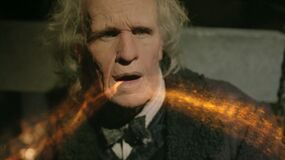
The 1976 serial TV: The Deadly Assassin set a challenge in establishing that Time Lord have a twelve regeneration limit, consisting of thirteen incarnations. The Valeyard would later be introduced in TV: The Mysterious Planet as a manifestation of the Doctor from "between his twelfth and final incarnations." Some readers have determined, as a result, that the final Doctor seen in PROSE: Alien Bodies would be the Thirteenth Doctor, having used up all twelve regenerations by the time of the War.[8]
Eventually, Steven Moffat decided to write his way out of the regeneration limit by having the Time Lords grant the Doctor a new regeneration cycle in TV: The Time of the Doctor, in order to allow the franchise to continue without breaking continuity with earlier Doctor Who serials, which he respected.[9]
An alternate ending
Death Comes to Time, produced in the years following the introduction of Paul McGann's Eighth Doctor but before plans were announced to revive the series, was an attempt to create a story that would act as the series finale for Doctor Who altogether. This ending would dovetail into a spin-off that would be the spiritual successor to Doctor Who, called The Minister of Chance. The would-be finale depicts the Seventh Doctor, as ever portrayed by Sylvester McCoy, making a final sacrifice, and an implied downfall of the Time Lord society prior to the events of the story, as the few Time Lords seen in the story are stated to be the last alive. The Doctor's companion, Ace, also ends up on her own, solemnly telling the Brigadier about the Doctor's demise. However, because the Doctor's body is never found, his final fate is unclear. Freedman explained that his plans for the Doctor Who reboot which would have followed on from Death Comes to Time would have been to carry on with a different main character picking up the Doctor's legacy, but that eventually, the Doctor would have been revealed to have survived, possibly even as Paul McGann's Eighth Doctor, though with the full circumstances of his survival regeneration left ambiguous and presumably not matching the events depicted in the 1996 TV movie.
Death Comes to Time would be referred to in several valid sources including, ironically, the BBC Eighth Doctor Adventures. Furthermore, Zagreus implies that the story takes place in an alternate reality which is glimpsed by the Eighth Doctor.
Video game mechanics
In video games such as The Adventure Games, the Doctor is susceptible to being killed by enemies such as the Daleks and the Cybermen, at which point the game resets to an earlier point.
Non-narrative sources
The final objective of the online video game NOTVALID: The Last Dalek was for the player-controlled Dalek to exterminate the Ninth Doctor and destroy the TARDIS.
Footnotes
- ↑ King, S.W. (4 May 2013). 50th Anniversary Blues. The Edwardian Adventurer. Retrieved on 12 January 2022.
- ↑ A.B., Digital Spy Forum. Twelfth Night: Adventures in Time and Space with Peter Capaldi. Edited by Andrew O'Day.
- ↑ Several authors. Fridge / Doctor Who – Meta. TV Tropes. Retrieved on 12 January 2022.
- ↑ Redfern, Mark (1 July 2008). Doctor Who's New Showrunner Remains Tightlipped. Under The Radar Magazine. Retrieved on 12 January 2022.
- ↑ Brew, Simon (6 June 2011). Doctor Who series 6: the loose threads still to resolve. Den of Geek. Retrieved on 12 January 2022.
- ↑ McMillan, Graeme (27 August 2011). Doctor Who Season 6: 5 Things To Remember About The Story So Far. CBR. Retrieved on 12 January 2022.
- ↑ Several authors (29 April 2011). Responses to "A spoileriffic Doctor Who question". The Reinvigorated Programmer. Retrieved on 12 January 2022.
- ↑ Wilson, Anthony. Goth Opera. The Cloister Library. Retrieved on 12 January 2022.
- ↑ Rigby, Sam (24 November 2013). 'Doctor Who': Steven Moffat on regeneration limit. Digital Spy. Retrieved on 12 January 2022.

